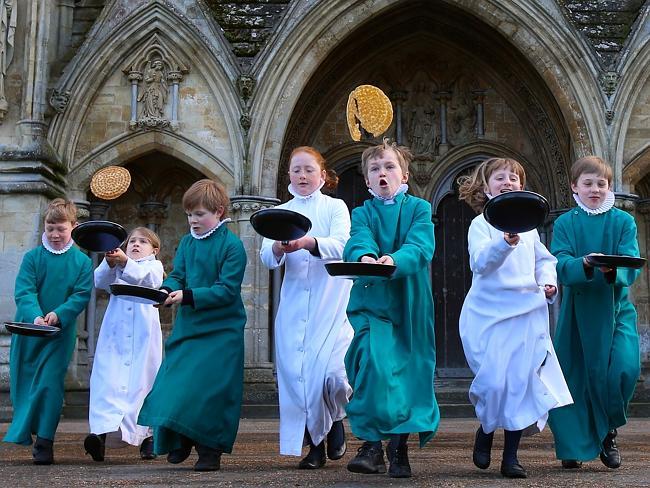Royal Shrovetide football game kicks off in Ashbourne with few rules but plenty of players
HUNDREDS of men, two teams, one ball, few rules. Bizarre tradition sees town boarded up as football frenzy hits the streets — and river.
THE strains of “God Save the Queen” have died down by the time a local businessman, standing on a three-metre-high plinth in the middle of a town-centre car park, tosses a leather ball into a vast sea of bodies.
Hundreds of men of all ages and builds, wearing a combination of rugby jerseys, hoodies and fleeces, grapple and tussle — in fact, use any means necessary — in frenzied attempts to grab the ball.
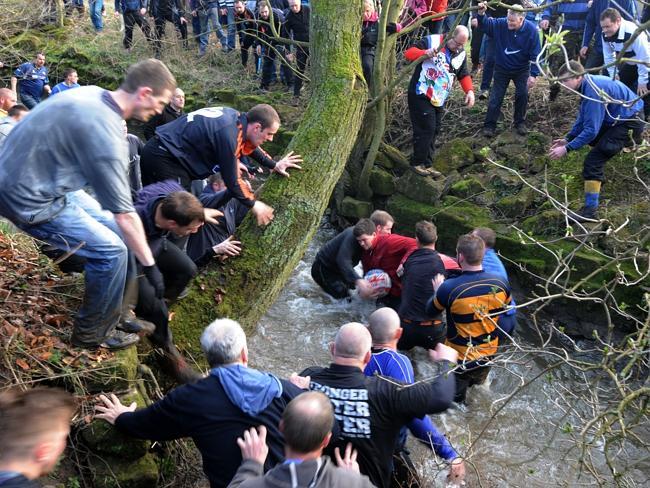
And so begins one of Britain’s most cherished, fabled and downright bizarre sporting traditions.
Played annually on Shrove Tuesday and Ash Wednesday ever since the late 1600s, and maybe even before, the Royal Shrovetide football game sees thousands of locals from rival sides of a sleepy market town in central England take part in a chaotic and often brutal contest.
The aim: To ‘goal’ the ball against scoring posts situated in the middle of a shallow river and three miles apart at either end of town. Injuries and black eyes are common — there have been broken legs and reportedly heart attacks, too.
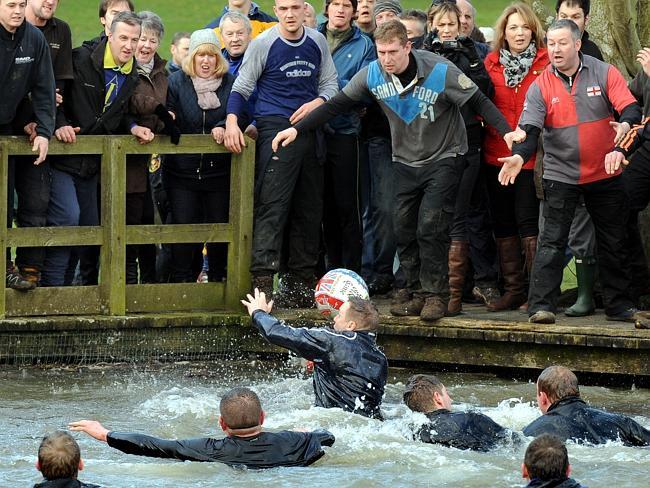
But it’s worth all the pain to have bragging rights over your fierce rivals for the next 12 months.
Don’t underestimate its importance to the locals.
“It’s chaos, it’s like a riot — an organised riot,” says Dave Leigh, a pub landlord in Ashbourne. “But they live and die by it.”
The game is regarded as a carry-over from the “mob football” matches played in the Middle Ages. These matches are believed to have spawned the global sporting phenomenon that is soccer, as well as rugby.
Many British towns have played Shrovetide down the centuries but Ashbourne is one of the few to carry on the tradition. Only twice has it been cancelled, in 1968 and 2001 — both times because of an outbreak of foot and mouth disease. It continued through both world wars.
And it has had the royal seal of approval — in 1928, the then-Prince of Wales (who would later become King Edward VIII) threw in the ball to start the game. In 2003, Prince Charles had the honour of being the so-called “turner-up”.
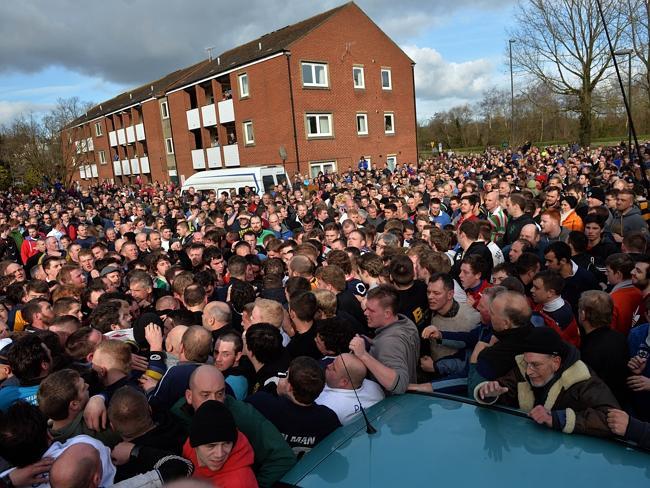
“Plenty of people seem to have tried over the years to stop this great tradition of Shrovetide,” the Prince said hours before the 2003 game, “but even over the two world wars, the men on active service wrote asking it should be carried on.
“Now why was it that they did that? Because, they said, it was one of the things they were fighting for, part of the old traditional England that has survived innovations and inventions.
“All I can say is you’ve got to keep it going, somehow or other.”
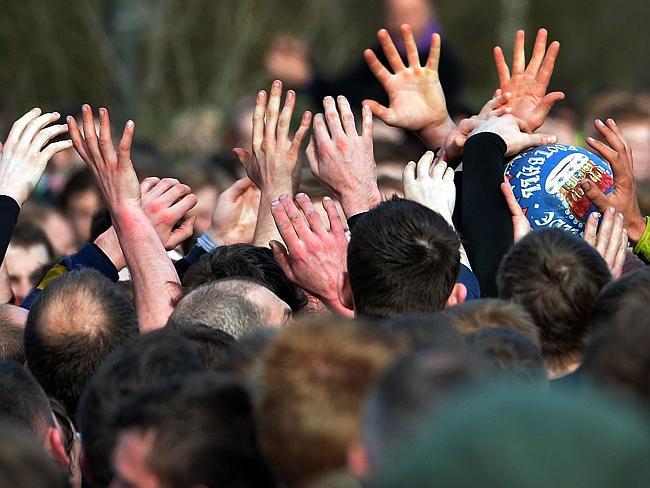
Ashbourne, a quaint, picturesque town in Derbyshire, virtually shuts down for the two-day event. Schools and businesses are closed.
Shops on the high street and other nearby roads are boarded up to stop their windows getting smashed. Signs approaching the town centre state: “Cars are parked at their owners’ risk.”
The only businesses doing a brisk trade are the pubs, from which locals spill out to watch the start of the game at 2pm.
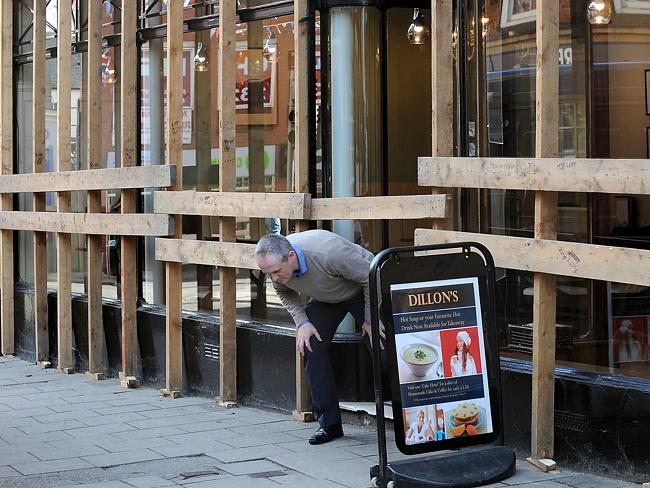
Football greats Brian Clough and Stanley Matthews are other famous names to have been the “turner-up” over the past 50 years but in 2014, the honour was given to local man Stuart Lees.
He was nominated for the role because of his charity and fundraising work as well as 30 years’ work for the local fire brigade.
He was carried, shoulder-high, through the throng of spectators and players to the plinth and started renditions of Auld lang syne and the national anthem before launching the event.
“It was unbelievable, seeing a complete car park full of people. It’s mind-blowing,” Mr Lees said. “Nothing else in the world compares to this — it’s a tradition that must never die.”

Players from the two teams — the Up’ards and the Down’ards — fight to gain possession of the ball as they move through Ashbourne in what is basically a giant rugby scrum.
The game is self-policed, has only a few loose rules — including no conveying the ball in a vehicle and no play in churchyards — and the competitors don’t wear uniforms.
So how do you know who is on who’s team? “Born and bred,” says publican Me Leigh. “You can just tell by the face.”
On the first day of play, it took nearly two hours for the swarm of players to move out the car park, through a housing estate to a fire station, into the River Henmore and over the other side. Thousands of spectators followed the scrum, screaming when they caught a glimpse of the ball.
There are unlikely to be more than two or three “goals” by the time the game finishes at 10pm on Wednesday, UK time.
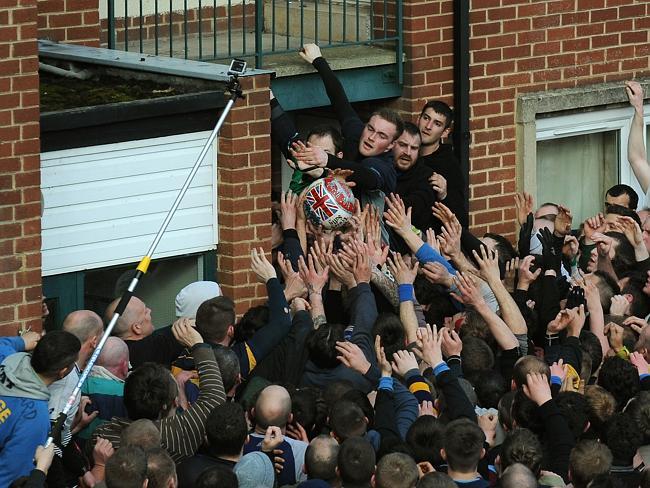
But any scorer is treated like a king, carried on the shoulders of his colleagues into the town centre.
“I’ve scored before,” said Simon Hellaby, a 46-year-old Up’ard. “It was up there with the birth of my kids.”
Elsewhere in England there was more Shrove Tuesday competition, but of a less dangerous variety, with traditional pancake races held across the country.
